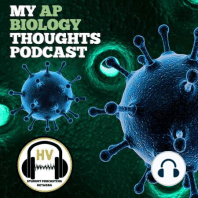23 min listen

The Making of a Protein (Organelles and Path)
The Making of a Protein (Organelles and Path)
ratings:
Length:
3 minutes
Released:
May 4, 2021
Format:
Podcast episode
Description
My AP Biology Thoughts Unit 2 Cell Structure and FunctionWelcome to My AP Biology Thoughts podcast, my name is Alex and I am your host for episode 50 called Unit 2 Cell Structure and Function: The Making of a Protein. Today we will be discussing the process of how proteins are formed inside cells.Proteins are one of the most important macromolecules. They are responsible for many essential functions in the body. They come in many forms such as enzymes, antibodies, and hormones.But how are proteins created in the body?First, transcription occurs to produce mRNA. DNA in the nucleus unwinds to expose the bases to act as a template. DNA polymerase breaks the hydrogen bonds between the bases. RNA polymerase then takes the exposed bases to create an RNA chain from the DNA. Once the whole strand is copied, the mRNA leaves the nucleus through the nuclear envelope pores. The mRNA then goes under some modifications such as adding a protective cap to protect the mRNA from enzymes. Furthermore, introns, or Junk DNA, is removed from the mRNA.Afterwards, the mRNA attaches to a ribosome in the cytoplasm, and begins the process of translation. Here the ribosome will work down the mRNA strand, 3 nucleotides at a time. The ribosome will take the 3 nucleotides and assign the corresponding amino acids to be linked. Now, the polypeptide chain undergoes three stages of folding to shape the protein for its specific function. The protein first folds using hydrogen bonds to hold the new structure together into a secondary structure such as an alpha helix. The next two steps are very similar to the first, with the protein undergoing further stages of folding to create a complex quaternary structure. Protein synthesis is one of the most vital aspects of biology. Organisms had evolved to use DNA as a blueprint for synthesizing proteins, which allows a cell to create a menagerie of different proteins to carry out different tasks. Thank you for listening to this episode of My AP Biology Thoughts. For more student-ran podcasts and digital content, make sure that you visit www.hvspn.com. See you next time!Music Credits:“Ice Flow” Kevin MacLeod (incompetech.com)Licensed under Creative Commons: By Attribution 4.0 Licensehttp://creativecommons.org/licenses/by/4.0/Subscribe to our PodcastApple PodcastsSpotifyGoogle Podcasts YouTube Connect with us on Social Media· Twitter
Released:
May 4, 2021
Format:
Podcast episode
Titles in the series (100)
Invasive Species by My AP Biology Thoughts